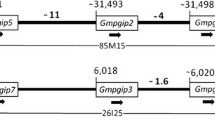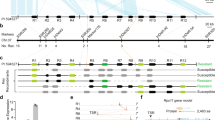Abstract
Fifteen Rps genes confer resistance against the oomycete pathogen Phytophthora sojae, which causes root and stem rot disease in soybean. We have isolated a disease resistance gene-like sequence from the genomic region containing Rps1-k. Four classes of cDNA of the sequence were isolated from etiolated hypocotyl tissues that express the Rps1-k-encoded Phytophthora resistance. Sequence analyses of a cDNA clone showed that the sequence is a member of the coiled coil-nucleotide binding site–leucine rich repeat (CC-NBS–LRR)-type of disease resistance genes. It showed 36% identity to the recently cloned soybean resistance gene Rpg1-b, which confers resistance against Pseudomonas syringae pv. glycinea, and 56% and 38% sequence identity to putative resistance gene sequences from lotus and Medicago truncatula, respectively. The soybean genome contains about 38 copies of the sequence. Most of these copies are clustered in approximately 600 kb of contiguous DNA of the Rps1-k region. We have identified a recombinant that carries both rps1-k- and Rps1-k-haplotype-specific allelomorphs of two Rps1-k-linked molecular markers. An unequal crossover event presumably led to duplication of alleles for these two physically linked molecular markers. We hypothesize that the unequal crossing over was one of the mechanisms involved in tandem duplication of CC-NBS–LRR sequences in the Rps1-k region.








Similar content being viewed by others
References
Anderson PA, Lawrence GJ, Morrish BC, Ayliffe MA, Finnegan EJ, Ellis JG (1997) Inactivation of the flax rust resistance gene M associated with loss of a repeated unit within the leucine-rich repeat coding region. Plant Cell 9:641–651
Arumuganathan K, Earle ED (1991) Nuclear DNA content of some important plant species. Plant Mol Biol Rep 9:208–218
Ashfield T, Bocian A, Held D, Henk AD, Marek LF, Danesh D, Penuela S, Meksem K, Lightfoot DA, Young ND, Shoemaker RC, Innes RW (2003) Genetic and physical localization of the soybean Rpg1-b disease resistance gene reveals a complex locus containing several tightly linked families of NBS-LRR genes. Mol Plant Microbe Interact 16:817–826
Ashfield T, Ong LE, Nobuta K, Schneider CM, Innes RW (2004) Convergent evolution of disease resistance gene specificity in two flowering plant families. Plant Cell 16:309–318
Bhattacharyya MK (2001) Construction of cDNA libraries. In: Brown TA (ed) Essential molecular biology: a practical approach, vol 2. Oxford University Press, Oxford, pp 42–62
Bhattacharyya MK, Ward EWB (1986) Expression of gene-specific and age-related resistance and the accumulation of glyceollin in soybean leaves infected with Phytophthora megasperma f.sp. glycinea. Physiol Mol Plant Pathol 29:105–113
Bhattacharyya MK, Gonzales RA, Kraft M, Buzzell RI (1997) A copia-like retrotransposon Tgmr closely linked to the Rps1-k allele that confers race-specific resistance of soybean to Phytophthora sojae. Plant Mol Biol 34:255–264
Cooley MB, Pathirana S, Wu HJ, Kachroo P, Klessig DF (2000) Members of the Arabidopsis HRT/RPP8 family of resistance genes confer resistance to both viral and oomycete pathogens. Plant Cell 12:663–676
Dangl JL, Jones JD (2001) Plant pathogens and integrated defence responses to infection. Nature 411:826–833
Dixon MS, Jones DA, Keddie JS, Thomas CM, Harrison K, Jones JD (1996) The tomato Cf-2 disease resistance locus comprises two functional genes encoding leucine-rich repeat proteins. Cell 84:451–459
Dixon MS, Hatzixanthis K, Jones DA, Harrison K, Jones JD (1998) The tomato Cf-5 disease resistance gene and six homologs show pronounced allelic variation in leucine-rich repeat copy number. Plant Cell 10:1915–1925
Flor HH (1955) Host–parasite interaction in flax rust—its genetics and other implications. Phytopathology 45:680–685
Gangloff S, Zou H, Rothstein R (1996) Gene conversion plays the major role in controlling the stability of large tandem repeats in yeast. EMBO J 15:1715–1725
Graham MA, Marek LF, Shoemaker RC (2002) Organization, expression and evolution of a disease resistance gene cluster in soybean. Genetics 162:1961–1977
Hayes AJ, Jeong SC, Gore MA, Yu YG, Buss GR, Tolin SA, Saghai Maroof MA (2004) Recombination within a nucleotide-binding-site/leucine-rich-repeat gene cluster produces new variants conditioning resistance to soybean mosaic virus in soybeans. Genetics 166:493–503
Hoffman T, Schmidt JS, Zheng X, Bent AF (1999) Isolation of ethylene-insensitive soybean mutants that are altered in pathogen susceptibility and gene-for-gene disease resistance. Plant Physiol 119:935–949
Hulbert SH, Webb CA, Smith SM, Sun Q (2001) Resistance gene complexes: evolution and utilization. Annu Rev Phytopathol 39:285–312
Kanazin V, Marek LF, Shoemaker RC (1996) Resistance gene analogs are conserved and clustered in soybean. Proc Natl Acad Sci USA 93:11746–11750
Kasuga T, Salimath SS, Shi J, Gijzen M, Buzzell RI, Bhattacharyya MK (1997) High resolution genetic and physical mapping of molecular markers linked to the Phytophthora resistance gene Rps1-k in soybean. Mol Plant Microbe Interact 10:1035–1044
Kim UJ, Birren BW, Slepak T, Mancino V, Boysen C, Kang HL, Simon MI, Shizuya H (1996) Construction and characterization of human bacterial artificial chromosome library. Genomics 34:213–218
Konieczny A, Ausubel FM (1993) A procedure for mapping Arabidopsis mutations using co-dominant ecotype-specific PCR-based markers. Plant J 4:403–410
Lander ES, Green P, Abrahamson J, Barlow A, Daly MJ, Lincoln SE, Newburg L (1987) MAPMAKER: an interactive computer package for constructing primary genetic linkage maps of experimental and natural populations. Genomics 1:174–181
Leister D, Ballvora A, Salamini F, Gebhardt C (1996) A PCR-based approach for isolating pathogen resistance genes from potato with potential for wide application in plants. Nature Genet 14:421–429
Leitz RA, Hartman GL, Pedersen WL, Nickell CD (2000) Races of Phytophthora sojae on soybean in Illinois. Plant Dis 84:487
Luck JE, Lawrence GJ, Dodds PN, Shepherd KW, Ellis JG (2000) Regions outside of the leucine-rich repeats of flax rust resistance proteins play a role in specificity determination. Plant Cell 12:13671–377
Lupas A (1997) Predicting coiled-coil regions in proteins. Curr Opin Struct Biol 7:388–393
Marek LF, Shoemaker RC (1997) BAC contig development by fingerprint analysis in soybean. Genome 40:420–427
Martin GB, Bogdanove AJ, Sessa G (2003) Understanding the functions of plant disease resistance proteins. Ann Rev Plant Biol 54:23–61
McDowell JM, Dhandaydham M, Long TA, Aarts MG, Goff S, Holub EB, Dangl JL (1998) Intragenic recombination and diversifying selection contribute to the evolution of downy mildew resistance at the RPP8 locus of Arabidopsis. Plant Cell 10:1861–1874
Meyers BC, Chin DB, Shen KA, Sivaramakrishnan S, Lavelle DO, Zhang Z, Michelmore RW (1998) The major resistance gene cluster in lettuce is highly duplicated and spans several megabases. Plant Cell 10:1817–1832
Michelmore RW, Meyers BC (1998) Clusters of resistance genes in plants evolve by divergent selection and a birth-and-death process. Genome Res 8:1113–1130
Pan Q, Wendel J, Fluhr R (2000) Divergent evolution of plant NBS–LRR resistance gene homologues in dicot and cereal genomes. J Mol Evol 50:203–213
Parniske M, Jones JD (1999) Recombination between diverged clusters of the tomato Cf-9 plant disease resistance gene family. Proc Natl Acad Sci USA 96:5850–5855
Parniske M, Hammond-Kosack KE, Golstein C, Thomas CM, Jones DA, Harrison K, Wulff BB, Jones JD (1997) Novel disease resistance specificities result from sequence exchange between tandemly repeated genes at the Cf-4/9 locus of tomato. Cell 91:821–832
Richly E, Kurth J, Leister D (2002) Mode of amplification and reorganization of resistance genes during recent Arabidopsis thaliana evolution. Mol Biol Evol 19:76–84
Salimath SS, Bhattacharyya MK (1999) Generation of a soybean BAC library, and identification of DNA sequences tightly linked to the Rps1-k disease resistance gene. Theor Appl Genet 98:712–720
Salmeron JM, Oldroyd GED, Rommens CMT, Scofield SR, Kim H-S, Lavelle DT, Dahlbeck D, Staskawicz BJ (1996) Tomato Prf is a member of the leucine-rich repeat class of plant disease resistance genes and lies embedded within the Pto kinase gene cluster. Cell 86:123–133
Sandhu D, Gao H, Cianzio S, Bhattacharyya MK (2004) Deletion of a disease resistance nucleotide-binding-site leucine-rich-repeat-like sequence is associated with the loss of the Phytophthora resistance gene Rps4 in soybean. Genetics 168:2157–2167
Schmitthenner AF (1989) Phytophthora rot. In: Sinclair JB, Backman PA (eds) Compendium of soybean diseases. APS, St. Paul, pp 35–38
Schmitthenner AF, Hobe M, Bhat RG (1994) Phytophthora sojae races in Ohio over a 10-year interval. Plant Dis 78:269–276
Shan W, Cao M, Leung D, Tyler BM (2004) The Avr1b locus of Phytophthora sojae encodes an elicitor and a regulator required for avirulence on soybean plants carrying resistance gene Rps1b. Mol Plant Microbe Interact 17:394–403
Simons G, Groenendijk J, Wijbrandi J, Reijans M, Groenen J, Diergaarde P, Van der Lee T, Bleeker M, Onstenk J, de Both M, Haring M, Mes J, Cornelissen B, Zabeau M, Vos P (1998) Dissection of the fusarium I2 gene cluster in tomato reveals six homologs and one active gene copy. Plant Cell 10:1055–1068
Song W-Y, Pi L-Y, Wang G-L, Gardner J, Holsten T, Ronald PC (1997) Evolution of the rice Xa21 disease resistance gene family. Plant Cell 9:1279–1287
Tyler BM (2002) Molecular basis of recognition between phytophthora pathogens and their hosts. Annu Rev Phytopathol 40:137–167
Ward EWB, Lazarovits G, Unwin CH, Buzzell RI (1979) Hypocotyl reactions and glyceollin in soybeans inoculated with zoospores of Phytophthora megasperma var. sojae. Phytopathology 69:951–955
Ward EWB, Stössel P, Lazarovits G (1981) Similarities between age-related and race-specific resistance of soybean hypocotyls to Phytophthora megasperma var. sojae. Phytopathology 71:504–508
Wei F, Gobelman-Werner K, Morroll SM, Kurth J, Mao L, Wing R, Leister D, Schulze-Lefert P, Wise RP (1999) The Mla (powdery mildew) resistance cluster is associated with three NBS-LRR gene families and suppressed recombination within a 240-kb DNA interval on chromosome 5S (1HS) of barley. Genetics 153:1929–1948
White JL, Kaper JM (1989) A simple method for detection of viral satellite RNAs in small plant tissue samples. J Virol Methods 23:83–94
Whitham S, Dinesh-Kumar SP, Choi D, Hehl R, Corr C, Baker B (1994) The product of the tobacco mosaic virus resistance gene N: similarity to toll and the interleukin-1 receptor. Cell 78:1101–1115
Wrather JA, Stienstra WC, Koenning SR (2001) Soybean disease loss estimates for the United States from 1996 to 1998. Can J Plant Pathol 23:122–131
Acknowledgements
We thank Catherine Baublite and GenomeSystems for constructing a BAC library, and Devinder Sandhu, Katherine G. Schallock, Janice Seibel, and Christy Trautmann for reviewing the manuscript. This work was funded by USDA–NRI (grant no. 2001-35301-10577); the Iowa Soybean Promotion Board, Department of Agronomy, Iowa State University; and the Samuel Roberts Noble Foundation.
Author information
Authors and Affiliations
Corresponding author
Additional information
Communicated by C. Möllers
N.N. Narayanan, H. Gao, D.K. Santra, and S.S. Salimath contributed equally to this work.
Rights and permissions
About this article
Cite this article
Bhattacharyya, M.K., Narayanan, N.N., Gao, H. et al. Identification of a large cluster of coiled coil-nucleotide binding site–leucine rich repeat-type genes from the Rps1 region containing Phytophthora resistance genes in soybean. Theor Appl Genet 111, 75–86 (2005). https://doi.org/10.1007/s00122-005-1993-9
Received:
Accepted:
Published:
Issue Date:
DOI: https://doi.org/10.1007/s00122-005-1993-9




